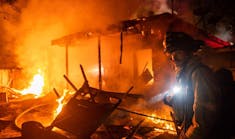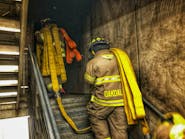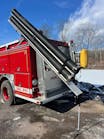The Fire Scene: Interior or Exterior: Where Do We Begin?
Some members of the fire service are looking into and experimenting with some variations of what have become standard firefighting tactics in many departments. You have all heard of the “interior attack,” sometimes called an “aggressive interior attack.” The interior-attack concept is one that calls for the arriving firefighters to stretch an attack hoseline into the involved structure, through the interior hallways, stairways and rooms, until they encounter the fire area, where they begin their attack on the fire from the unburned to the burned area. This concept and practice has served us well for decades and many firefighters, officers and chiefs have worked entire careers following this plan of attack.
More recently, a group of members of the FDNY, along with Underwriters Laboratories (UL) and the National Institute of Standards and Technology (NIST), are conducting research and experiments involving a series of “live-burn” evolutions. These experiments are taking a look at several important issues, such as the changing dynamics of fire, which is the increased use of plastics and other synthetic materials in the furnishings we routinely encounter at fires. This change in dynamics has resulted in a change in the “flashover” timeline and an earlier moment of flashover in burning buildings. This change can also result in firefighters being inside and at the point of flashover when they are beginning their interior attack.
Tactical issues
Some of the issues being examined are when ventilation should be conducted and when and where the first water should be used for the attack. One of the points made is that if we simply enter the building and penetrate to the edge of the fire area, we may be operating in an extremely dangerous area that could suddenly flash over.
This has been a basic tactic that many departments practice at structural fires. We arrive at a building with fire issuing from two front windows. Some of us pull our hoselines and some enter to locate the fire and vent the building. As the hoseline is being stretched, the ventilation of the building lets the smoke and heated gases rise up and out of the building or to vent horizontally as the hoseline advances into the fire area.
This collection of tactics has obviously worked well for many years in many departments, but is now being looked at from a risk-vs.-reward perspective. Controlling and limiting ventilation, they say, will decrease the chances of firefighters experiencing unexpected flashovers while operating inside the structure. Another issue is the initial application of water on the fire. For years, fire departments have been told to refrain from directing streams into burning buildings from the exterior because this tactic could drive fire and heat to other uninvolved areas of the building, spreading the fire and endangering trapped occupants.
These new experiments have produced results that challenge those long-held beliefs. During the live-burn experiments, the buildings were outfitted with numerous sensors that measured temperature, heat flows, toxic gas concentrations and other factors. Along with video recordings of the burning building, these sensors showed that contrary to our previous beliefs, the application of the first stream into the window of the fire room resulted in a decrease of temperatures and general improvement on conditions throughout the building. This “resetting” of the fire makes conditions more favorable for an interior fire attack and does not spread or increase the fire conditions. Additionally, it changes conditions inside the burning building where the firefighters will be beginning their interior fire attack and greatly diminishes the chances of a flashover occurring where they are working.
Still more questions
The recent experiments and their results, although limited, have shed a new light on the tactics that many fire departments use every day. The intent of these tests is to guide improvements in fire department tactics, looking at current information and conditions. Does a series of 20 or 40 or even 100 live-fire experiments change what have been accepted as standard operating procedures (SOPs) for many years? The answer, of course, is no, not immediately. But you must admit that some of the results of these well-planned and well-conducted experiments are eye openers. They still leave me with the following questions:
• If we direct the first hoseline into a window of a burning room, will we be able to get the nozzle team to move away from there and enter the building for the interior attack?
• Can narrow streams be used for this tactic or are smooth-bore nozzles required?
• Can other firefighters enter a building for search while the line is operating into the window of fire?
• What if just one window is opened somewhere in the building, could that condition allow or promote fire to be driven in that direction by an outside stream?
These questions and many more are being asked about this new view of fire attack. Like every other tactic and concept in the American fire service, there will always be supporters and detractors. What do you think? If you would like to take a better look at this issue, visit www.nyc.gov/html/fdny/html/events/2012/070312a.shtml#vid and www.nist.gov/el/fire_research/firetech/project_tactics.cfm.
Chief Salka takes a candid look at news and events impacting the fire service in his blog “The Fire Scene” at http://www.firehouse.com/blogs/the-fire-scene.
JOHN J. SALKA Jr., a Firehouse® contributing editor, recently retired as a battalion chief with FDNY, serving as commander of the 18th battalion in the Bronx. Salka has instructed at several FDNY training programs, including the department’s Probationary Firefighters School, Captains Management Program and Battalion Chiefs Command Course. He conducts training programs at national and local conferences and has been recognized for his firefighter survival course “Get Out Alive.” Salka co-authored the FDNY Engine Company Operations manual and wrote the book First In, Last Out – Leadership Lessons From the New York Fire Department. He also operates Fire Command Training (www.firecommandtraining.com), a New York-based fire service training and consulting firm.

John J. Salka Jr. | Battalion Chief
JOHN J. SALKA JR., who is a Firehouse contributing editor, retired as a battalion chief with FDNY, serving as commander of the 18th battalion in the Bronx. Salka has instructed at several FDNY training programs, including the department’s Probationary Firefighters School, Captains Management Program and Battalion Chiefs Command Course. He conducts training programs at national and local conferences and has been recognized for his firefighter survival course, “Get Out Alive.” Salka co-authored the FDNY Engine Company Operations manual and wrote the book "First In, Last Out–Leadership Lessons From the New York Fire Department." He also operates Fire Command Training, which is a New York-based fire service training and consulting firm.






